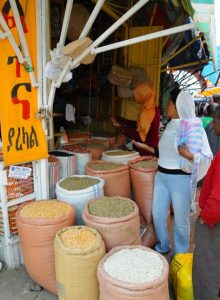

While reading this article I was constantly reminded of my experience in Addis Abeba, Ethiopia which is home to Africa’s largest outdoor market. The renowned “Addis Mercato” (meaning “new market” – first half in Amharic, second in Italian) is a melting pot of culture/traditions from all over the Middle East and North-East Africa. Addis Mercato is comprised of over 7000 privately owned businesses that stretch over Kenya St. It was very chaotic but I loved learning about its rich history and shopping around. Near the end of page 17 of the article, it reads “what is crowded to some people may be cozy to others. How could perceptions of space be natural or anything but as socially constructed as the built environment? Not only is there a socio-political story behind the built environment, but its meaning and use keep evolving. And as cities become increasingly heterogeneous or democratic, understandings and ideas of space may clash.” This got my attention because it accurately describes the conflict happening right now in regards to Mercato’s future. The government along with many big real-estate companies are aspiring for a more “modern” Addis Abeba but fail to see the beauty of Mercato in all its mayhem. Every inch of the sidewalk is occupied with goods and services that attract thousands of customers daily, which intern help keep the families well off financially. It is very hard for these sidewalk vendors to stand their ground against those in authority, but there’s power in numbers so they are still negotiating. While I was there I saw many coffee shops — one of the major selling points is because coffee beans originated in Ethiopia so many tourists want to taste Ethiopian coffee, the first of its kind. Taking this into consideration it has now become more than just a market but a staple for Ethiopian tourism.
“Our shorthand definition for critical cartography is to “map the unmapped,” which included the physical sidewalks, the people on the sidewalks, and the social negotiation of this space .” I completely agree with this statement. Something I noticed while walking along those sidewalks is that there isn’t any sort of mapping established. Unless you have been coming there for years familiarizing yourself with the layout and on top of that trying to find a specific item is very difficult. The vendors themselves have verbally agreed to organize their shops in a specific way and since there are no written contracts it is subject to change quite frequently. Even google maps doesn’t show you a clear street view, but instead, a 360 camera shot taken in one location by a tourist is linked to the street. One thing that I would think would help is some sort of system that actually accounts for the amount of consumerism that occurs here. In addition, those in power can work together with the vendors to try to find a feasible and fair solution. At the end of the day, closing down the entire or even sections of Mercato would affect both the street vendors and the people that rely on vendors as their main source of food, clothing, fuel, and many more.

